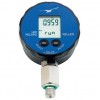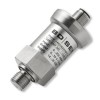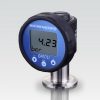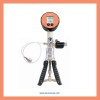Suction pressure is a negative difference in pressure generated between two points which draws a gas or a liquid from a higher to a lower pressure state.
For example if the inlet pressure of a vacuum pump is at 900 mbar absolute and it is connected to a closed chamber at an atmospheric pressure of 1000 mbar absolute, the resulting suction pressure is 100 millibar negative gauge, which will draw down the pressure in the chamber from 1000 to 900 mbar absolute.
Suction pressure applications are prevalent across diverse industries. These include, but are not limited to, vacuum systems used in semiconductor manufacturing, HVAC systems where fans create negative pressure to circulate air, medical applications such as ventilators and suction equipment, and industrial processes involving pumps and compressors.
 Vacuum, Suction Pressure Data Loggers, Recorders - Select vacuum data loggers for precise recording of negative suction and absolute pressures. Ideal for process analysis, test reports, and system validation in industrial and research settings.
Vacuum, Suction Pressure Data Loggers, Recorders - Select vacuum data loggers for precise recording of negative suction and absolute pressures. Ideal for process analysis, test reports, and system validation in industrial and research settings. Suction Pressure Sensors - Suction pressure sensors for measuring negative gauge reference pressure. Select pressure sensors for measuring the level of pressure below ambient atmospheric pressure.
Suction Pressure Sensors - Suction pressure sensors for measuring negative gauge reference pressure. Select pressure sensors for measuring the level of pressure below ambient atmospheric pressure. Suction Pressure Transmitters - Find suction pressure transmitters designed for precise negative pressure measurement relative to ambient. Ideal for industrial vacuum control and monitoring applications.
Suction Pressure Transmitters - Find suction pressure transmitters designed for precise negative pressure measurement relative to ambient. Ideal for industrial vacuum control and monitoring applications. Suction Pressure Transducers - Choose suction pressure transducers with 0-5V or 0-10Vdc outputs. Ideal for measuring suction from millibars to 1 bar, ensuring linear and precise vacuum monitoring.
Suction Pressure Transducers - Choose suction pressure transducers with 0-5V or 0-10Vdc outputs. Ideal for measuring suction from millibars to 1 bar, ensuring linear and precise vacuum monitoring. Vacuum, Suction, Negative Pressure Gauges - Explore digital gauges using piezoresistive & capacitance sensors for low to partial vacuum, suction, and negative pressure. Ideal for industrial & lab applications.
Vacuum, Suction, Negative Pressure Gauges - Explore digital gauges using piezoresistive & capacitance sensors for low to partial vacuum, suction, and negative pressure. Ideal for industrial & lab applications. Suction Pressure Calibration Equipment - Select a calibration equipment for calibrating suction pressure measuring devices, and generating suction pressure for setting calibration points.
Suction Pressure Calibration Equipment - Select a calibration equipment for calibrating suction pressure measuring devices, and generating suction pressure for setting calibration points.
Questions & Answers
Applying negative pressure to pressure transducer
What happens inside a pressure transducer when negative pressure is applied?
Before negative pressure is applied, there is an equal pressure on the front and rear side of the sensor diaphragm. When the negative pressure is applied, the rear side pressure is now higher than the front side pressure. This causes the sensing diaphragm to flex in the reverse direction resulting in a negative output signal. The negative output signal is often converted to a standardised positive signal such as 4-20mA, 0-10V or 0-5V.
Sensor types for measuring suction pressure
What type of sensing technology is used for measuring suction pressure?
For suction pressures in the range of 0-10 mbar (~0.15 psi) up to
0-1000 mbar (~15psi) it is possible to use strain gauge diaphragm technology. For ranges 0-0.1 mbar up to 0-10 mbar the sensitivity is too small and errors are too great to use a strain gauge diaphragm, so for very low pressures a more sensitive technology such as variable capacitance, inductive or LVDT is used.
Using suction pressure gauge to simulate altitude
Is it possible to use a gauge which reads a vacuum from 0 to -1 bar and convert it to an altitude reading for purposes of simulating altitude testing?
A 0 to -1 bar gauge reference range does not have a fixed reference because the zero reading floats on the atmospheric pressure reading which is constantly changing. In order to set an altitude you need to be able to set the same absolute pressure each time. This would only be possible with a 0 to -1 bar gauge range if you were able to compensate for atmospheric pressure. So it is not going to work unless you are able to continuously compensate for the local atmospheric pressure changes.
Difference between suction pressure & vacuum
What is the difference between suction pressure and vacuum?
Suction pressure is always measured by the amount of pressure below atmospheric pressure e.g. a suction pressure of 100 mbar means 100 mbar below the atmospheric air pressire. Vacuum pressure is similar but should be referred to perfect vacuum e.g. a vacuum of 100 mbar means 100 mbar above a perfect vacuum.
However vacuum is often confused with suction pressure so a pressure described as a vacuum should always be verified to ascertain whether it is referred to atmospheric pressure or a perfect vacuum.
Related Help Guides
- Measuring vacuum with negative gauge or absolute ranges
- What is the difference between vacuum and absolute pressure
- Can you measure vacuum using a gauge pressure range
- Measuring negative pressure using a positive differential pressure range
- Can you have a minus 20 psi gauge vacuum measurement range
- What does negative and positive gauge pressure mean
- Measuring vacuum as a negative gauge pressure using a dp sensor
- Measuring vacuum as an absolute range using a dp sensor
- Output signal orientation for a negative gauge pressure range
Related Technical Terms
Related Online Tools
Related Product and Application Guides
Related Application Questions and Answers
- Leak testing set for checking 1mb/min drop at negative 10 mbar vacuum
- Vacuum suction sensor & wall mount digital readout with switched contacts
- Vacuum pump inlet to outlet differential pressure sensor with 1500 Torr range
- Negative room pressure monitor and logger for multiple zones
- Vacuum digital gauge to measure 0 to 1000 mbar absolute
- 450 mmHg vacuum range pressure gauge
Contact us about this Suction Pressure page to request more information, or to discuss your application requirements.

